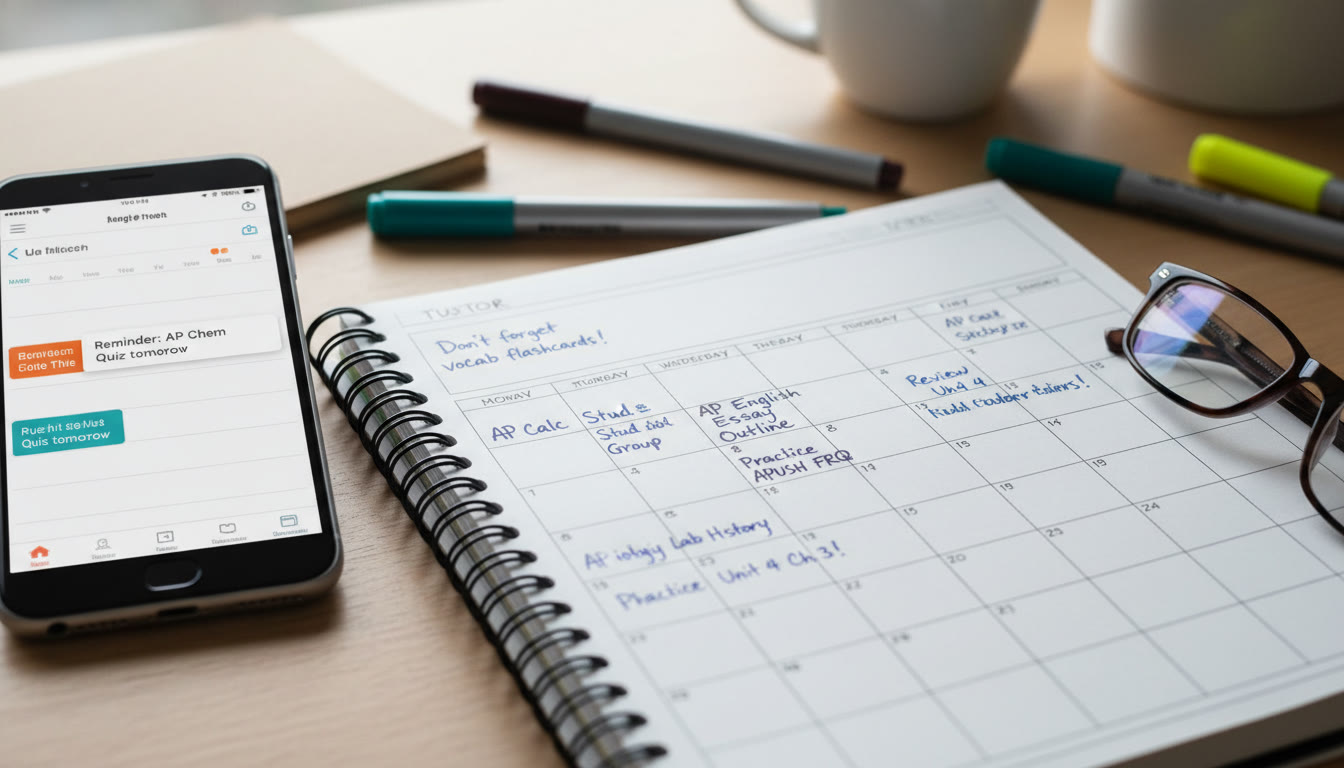Why a Study System Reset Might Be the Best Move
You started the year with a plan: review chapters, take practice tests, and aim for that sweet 4 or 5 on exam day. Then life happened — a surprise sports season, a tough unit in class, or the realization that your current routine just isn’t producing results. If you’re wondering whether you should try harder or start over, this post is for you. A study system reset isn’t failure; it’s strategy. It’s the conscious decision to trade inefficiency for intention.

When to Consider a Reset
Not every bad week means you need a full reset. But a system reset becomes wise when patterns — not one-offs — appear. Look for these telltale signs:
- You study for hours but your practice-test scores stagnate or slide.
- You’re constantly cramming the night before and burning out.
- Your study sessions are distracted, unfocused, or very last-minute.
- You can’t explain why you missed the same kinds of questions on multiple practice tests.
- Your schedule is chaotic because of non-academic demands and you can’t form a realistic routine.
If two or more of the above sound familiar, give yourself permission to pivot. The goal isn’t more work — it’s smarter, sustainable work.
What a Good Reset Looks Like: The 5-Part Framework
Think of the reset as a mini-project with five clear phases: Reflect, Diagnose, Design, Execute, Review. Each phase is small but decisive — and together they turn stress into a concrete plan.
1) Reflect — Be Honest, Be Kind
Spend one quiet study session writing answers to three questions: What’s working? What’s not? What’s within my control to change? This is not a blame exercise. It’s an inventory. Honesty here saves hours later.
2) Diagnose — Find High-Leverage Problems
Diagnose by looking at evidence: timing on practice exams, types of mistakes (careless, content gap, timing, misunderstanding the question), and energy levels during study. A simple table helps organize this information and points you to the right fixes.
| Symptom | Likely Cause | Recommended Fix |
|---|---|---|
| Stagnant practice-test scores | Study is unfocused; poor review strategy | Active review, spaced repetition, error logs |
| Rushed free-response answers | Poor time management or unclear rubric knowledge | Timed practice with rubric-based checklists |
| Careless arithmetic mistakes | Rushed or distracted during questions | Slow practice focusing on accuracy; micro-breaks |
| Anxiety the week before exams | Overload and lack of recovery | Strategic tapering, sleep, and simulation days |
3) Design — Build Your New, Realistic System
Designing a study system is like creating a lightweight experiment: set a hypothesis, define measures, and choose a short test window (2–4 weeks). Your system should include:
- A weekly rhythm of focused study blocks (Pomodoro or 50/10), not vague “study more” goals.
- Targeted content days and mixed-practice days (don’t just re-read notes).
- Explicit practice tests every 7–14 days, with a strict error-analysis protocol.
- Non-negotiables: sleep, movement, and one recovery day each week.
Example weekly plan for an AP student balancing school and prep:
| Day | Evening Focus (60–90 min) |
|---|---|
| Monday | Targeted review: one weak unit (active recall + flashcards) |
| Tuesday | Timed practice section (multiple choice) + error log |
| Wednesday | Content synthesis: create one-page concept map |
| Thursday | Free-response practice (timed) + rubric review |
| Friday | Mixed practice or lighter review; active recall |
| Saturday | Full or half practice exam every 1–2 weeks; review mistakes |
| Sunday | Rest, light review, plan next week |
4) Execute — Small Wins, Clear Feedback
Execution is where many plans fall apart. Use these practical rules to stay on track:
- Start with a 2–4 week pilot. Measure one or two variables (e.g., practice test score, percent of timed free responses completed).
- Keep an error log: for every incorrect question record the category (concept, careless, timing, misread) and what you’ll do differently next time.
- Block distractions: phone in another room, website blockers, or a study buddy for accountability.
- Celebrate progress: small rituals (a favorite snack, playlist) help cement the habit.
5) Review — Iterate or Scale
At the end of the pilot window, review your metrics. Did your timed practice accuracy improve? Are you more confident with free-response rubrics? If yes, scale the system up. If not, tweak one element — maybe your study blocks are too long, or your practice tests are too infrequent.
Common Pivot Patterns — And How to Handle Them
Not all pivots require a full reset. The trick is to match the size of the change to the size of the problem.
Panic Pivot: Taper and Prioritize
When exams are weeks away and panic sets in, large-scale learning is less effective than prioritization and consolidation. The priorities should be:
- Close high-frequency knowledge gaps (concepts that appear repeatedly on practice tests).
- Do at least two timed practice sections; focus on accuracy and pacing.
- Taper study volume 3–4 days before the exam to preserve mental energy.
Long-Term Pivot: Rebuild Foundation
If you’ve been struggling for months, a deep pivot may be needed: replace passive rereading with active learning — teach the concept out loud, create practice problems, or build concept maps. Add spaced repetition for retention and commit to regular, coached practice.
Distraction Pivot: Design for Real Life
Students with busy schedules need systems that accept interruptions. Short, high-quality sessions (25–40 minutes) with built-in review windows can outperform marathon sessions that get derailed.
Tools and Tactics That Actually Move the Needle
Here are pragmatic study tools and how to use them — not because they’re trendy, but because they solve specific problems.
Error Logs
Record every missed question for the first two weeks of a reset. Note: the question source, mistake type, and one corrective action. Then review the log weekly and prioritize recurring errors.
Spaced Repetition (SRS)
SRS isn’t just flashcards. Use it for formulas, definitions, and key facts. Start with a small set (30–50 items) and expand. The goal is retention without endless review.
Active Recall and Teaching
Explain a concept aloud — to a friend, parent, or even an empty room. Teaching reveals weak links faster than re-reading ever will.
Timed Simulation Days
Every 1–2 weeks do a timed section or full practice exam under strict conditions. Afterward, spend as much time reviewing mistakes as you did taking the test.
Sample 4-Week Reset Plan (AP Chemistry Example)
This section shows a concrete reset example for a student who scores low on practice tests because of pacing and concept gaps.
| Week | Focus | Key Actions |
|---|---|---|
| Week 1 | Diagnostics & Foundation | Take a timed practice exam; create an error log; identify top 5 weak topics |
| Week 2 | Targeted Concept Work | Daily focused sessions on each weak topic (45 min), SRS for formulas |
| Week 3 | Mixed Practice & Timing | Alternating timed sections and free-response practice; review rubrics |
| Week 4 | Simulation & Taper | Full practice exam mid-week, light review, sleep and recovery leading to exam |
How Personalized Tutoring Can Smooth the Pivot
A reset works faster with expert guidance. Personalized tutoring — one-on-one coaching — helps in three big ways:
- Immediate diagnosis: an experienced tutor spots patterns in mistakes faster than you can and prescribes targeted practice.
- Accountability and pacing: regular check-ins keep your pilot window honest and adaptive.
- Tailored study plans: instead of generic advice, tutors craft practice centered on your unique mix of strengths and gaps.
For students who need an integrated solution, Sparkl’s personalized tutoring blends expert human tutors with AI-driven insights to create tailored study plans, deliver 1-on-1 guidance, and track progress — helpful when you’re resetting and need a reliable co-pilot.
Mindset Shifts That Make a Reset Stick
Changing tactics is easier when you shift how you think about studying. Try these reframes:
- From “I need more hours” to “I need higher-quality hours.”
- From “I must be perfect” to “I will learn from errors.”
- From “I’ll cram later” to “I’ll schedule strategic consolidation.”
Small mindset shifts protect you from burnout and create a sustainable rhythm for peak performance.
Real-World Examples: Small Changes, Big Results
Here are two anonymized vignettes that show how a reset can play out:
Case One — The Careless Mistake Loop
Situation: A senior missed points on multiple-choice sections because of careless errors despite knowing the content. Reset: They shortened study blocks, added a 2-minute forced-check routine per question, and kept an error log focused only on careless mistakes. Result: Their practice-section accuracy improved by 10 percentage points in four weeks.
Case Two — The Rubric Blindspot
Situation: An AP English student wrote thoughtful essays but lost points because responses didn’t match the rubric. Reset: They spent two weeks reversing the process — first learning the rubric inside-out, then practicing targeted prompts that required rubric-based checklists. Result: Free-response scores rose as graders found evidence in predictable places.
When Not to Reset
Not every struggle calls for change. Don’t reset if:
- You had one bad practice test during an otherwise consistent track record.
- Your stress is temporary (a family event, illness) and you can return to your plan in a week or two.
- Changes would add complexity rather than clarity — a smaller tweak is better.
Checklist: Ready to Reset?
Use this quick checklist to decide if now is the right time for a reset and what kind of change you need.
- Evidence of persistent stagnation or repeated error types: yes / no
- Can you commit to a 2–4 week pilot? yes / no
- Have you listed 1–3 measurable goals (score target, timing, accuracy)? yes / no
- Do you have an accountability plan (tutor, teacher, friend)? yes / no
If you answered yes to all four, you’re ready. If not, pick the one missing piece and fix it first.

Final Notes: Embrace the Iteration
Resetting your study system is a skill — like editing an essay or solving a tough problem. It gets easier the more you do it. Start small, measure honestly, and use consistent review to turn short-term changes into long-term gains. If you need a partner for the reset, consider options that combine human expertise with data-driven insights; a few sessions of targeted, personalized tutoring can radically shorten the learning curve and give you a plan you’ll actually follow.
Parting Thought
Your AP score is a snapshot of your preparation at a moment in time, not a measure of potential. A system reset is less about proving something to others and more about optimizing your own process. Be curious, be methodical, and don’t be afraid to pivot when the evidence tells you it’s time.
Quick Resources to Start Your Reset
- Make an error log template and use it for two weeks.
- Schedule one timed practice section each week and one full practice exam every two weeks.
- Set a 2–4 week pilot window and decide on two measurable outcomes.
Good luck — and remember: a smart reset now could be the difference between scrambling and showing up confident on test day.



















No Comments
Leave a comment Cancel